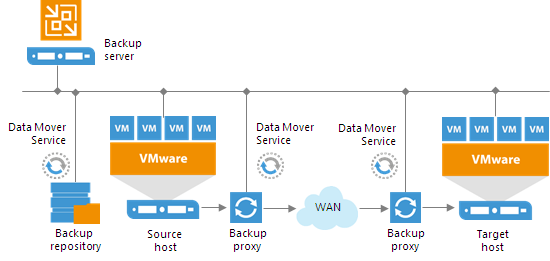 This is an archive version of the document. To get the most up-to-date information, see the current version.
This is an archive version of the document. To get the most up-to-date information, see the current version.Offsite Replication
If the source host is located in the primary site and the target host is located in the DR site, you can perform offsite replication.
Offsite replication can run over two data paths:
- Direct data path
- Via a pair of WAN accelerators
|
When planning for offsite replication, consider advanced possibilities to reduce the amount of replication traffic and streamline replica configuration. These include replica seeding, replica mapping, network mapping and re-IP. |
Replication Over Direct Data Path
The common requirement for offsite replication is that one Data Mover Service runs in the production site, closer to the source host, and another Data Mover Service runs in the remote DR site, closer to the target host. During backup, the Data Mover Services maintain a stable connection, which allows for uninterrupted operation over WAN or slow links. For more information, see Resume on WAN Disconnect.
Offsite replication over a direct path requires the following backup infrastructure components:
- At least one backup proxy in the source site. The backup proxy must have access to the backup server, source host, backup proxy in the target site and backup repository holding replica metadata.
- At least one backup proxy in the target site. The backup proxy must have access to the backup server, target host and backup proxy in the source site.
- Backup repository for storing replica metadata. The backup repository must be located in the source site, closer to the backup proxy, and must have access to it.
In the offsite replication scenario, Veeam Backup & Replication uses data compression. The Data Mover Service on the source backup proxy compresses VM data blocks and sends them to the target backup proxy in the compressed format. The Data Mover Service on the target backup proxy uncompressed VM data and stores it to a datastore in a native VMware format.

Replication via WAN Accelerators
If you have a weak WAN link, you can replicate VM data via a pair of WAN accelerators. WAN accelerators provide advanced technologies to optimize VM data transfer:
- Global data caching and deduplication
- Resume on disconnect for uninterrupted data transfer
WAN accelerators add a new layer in the backup infrastructure — a layer between the source-side Data Mover Service and the target-side Data Mover Service. The data flow goes from the source backup proxy via a pair of WAN accelerators to the target backup proxy that, finally, destinies VM data to the target host.
Offsite replication over WAN accelerators requires the following backup infrastructure components:
- A pair of WAN accelerators at each end of a WAN link:
- Source WAN accelerator in the source site. The source WAN accelerator must have access to the backup server, source backup proxy and to the target WAN accelerator.
- Target WAN accelerator in the target site. The target WAN accelerator must have access to the backup server, source WAN accelerator and target backup proxy.
- At least one backup proxy in the source site. The backup proxy must have access to the backup server, source host, source WAN accelerator and the backup repository holding replica metadata.
- At least one backup proxy in the target site. The backup proxy must have access to the backup server, target host and target WAN accelerator.
- Backup repository for storing replica metadata. The backup repository must be located in the source site, closer to the backup proxy, and must have access to it.
In the offsite replication scenario via WAN accelerators, Veeam Backup & Replication uses data compression. VM data blocks are compressed on the source WAN accelerator, transported to the target site in the compressed format and decompressed on the target WAN accelerator.